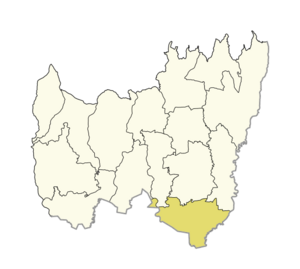Kachankawal Rural Municipality
Kachankawal
कचनकवल | |
|---|---|
| Kachankawal Rural Municipality | |
 Location of Kachankawal in Jhapa District | |
 Ward divisions of Kachankawal | |
 Kachankawal Location in Province No. 1 | |
| Coordinates: 26°25′53″N 88°02′00″E / 26.431521°N 88.033213°ECoordinates: 26°25′53″N 88°02′00″E / 26.431521°N 88.033213°E | |
| Country | |
| Province | Province No. 1 |
| District | Jhapa |
| Total Wards | 7 |
| Established | March 2017 |
| Seat | Baniyani |
| Government | |
| • Type | Rural Council |
| • Body | Kechanakawal Rural Council |
| • Chairperson | Mr. Anjar Alam (RPP) |
| • Vice-chairperson | Mrs. Nimsari Rajbanshi (RPP) |
| Area of Municipality | |
| • Total | 110 km2 (40 sq mi) |
| Population (2011) | |
| • Total | 39,593 |
| • Density | 360/km2 (930/sq mi) |
| Languages | |
| • Official | Nepali Local language Rajbanshi,Surjapuri]] |
| Time zone | UTC+5:45 (NST) |
| Postal code | 57200 |
| Website | Official website |
Kachankawal (Nepali: कचनकवल) is a rural municipality out of 7 rural municipalities of Jhapa District of Province No. 1 of Nepal. There are total 15 local administrative units in Jhapa District in which 8 are urban and 7 are rural municipalities.
Kachankawal rural municipality has an area of 110 square kilometres (42 sq mi) and total population according to the 2011 Nepal census is 39,593.[1] The rural municipality was established merging former VDCs: Gherabari, Pathariya, Kechana, Pathamari, Baniyani and Balubadi.[2]
Mr. Anjar Alam of RPP has elected as a chairperson of the rural municipality and Mrs. Nimsari Rajbanshi of the same party elected for the Vice-chairperson after the results of the local level elections held in Nepal on 28 June 2017.[3]
Kechana Kawal the lowest point of Nepal, which elevation is 58 m above sea level is located in this rural municipality.
Constituencies[]
- Parliamentary constituency: Kachankawal RM is a part of Jhapa 3 parliamentary constituency and Rajendra Prasad Lingden is the MP of Jhapa 3 who was elected in 2017 Nepalese general election, who is the candidate of Rastriya Prajatantra Party.
- Provincial constituency: Kachankawal with Bhadrapur Municipality comprises "Jhapa 3 (A)" Provincial constituency and Bashanta Kumar Baniya (Nepal Communist Party) is the MLA.[4][5][6]
Neighborhoods[]
Demographics[]
Total population of the Kachankawal RM is 39,593 with 8,742 households, in which 20,832 (51.5%) are female and remaining all 18,761 are male according to the 2011 Nepal census. 66% of the total population can read and write which is categorised as "Educated people". The number of educated female is lower than male. Only 56% female of the total female population (20,832) are educated while 76% male are educated.
Major population of the RM is Hinduism follower. 79% of the total population follow Hinduism while Islam is the second largest religion in the RM with 15% follower. Remaining 6% population follow Buddhism, Kirat, Christianity etc. There are castism in Hindus. Hindus are categorised in many casts as follows:
| 1 | Hindus | 79% |
|---|---|---|
| a | Rajbanshi | 35.5% |
| b | Bahun | 12.9% |
| c | Chhetri | 8.5% |
| d | Gangai | 8.3% |
| e | Santhal | 3.5% |
| f | Limbu | 2.3% |
| g | Tamang | 1.5% |
| h | Yadav | 1.4% |
| i | others | 11.6% |
| 2 | Muslim | 15% |
| 3 | Others | 6% |
Rajbanshi is the biggest group in the RM so Rajbanshi language is most spoken language with 44% speaker. Nepali is the 2nd most spoken language with 25% speaker. Remaining 31% speaks Urdu, Maithili, Santhali, Limbu, tamang etc.[7]
References[]
- ^ "Kachankawal Rural municipality in Nepal". www.citypopulation.de. 8 October 2017. Retrieved 15 March 2018.
- ^ "कचनकवल गाउँपालिका". Ministry of Federal Affairs and General Administration. Archived from the original on 31 August 2018. Retrieved 15 March 2018.
- ^ "RPP becomes victorious at Kachankawal Rural Municipality". www.khabarera.com. 3 July 2017. Retrieved 15 March 2018.
- ^ "Jhapa" (PDF). Election Commission of Nepal. Retrieved 17 April 2021.
- ^ "Election 2017Federal Parliament & Provincial Assembly". KMG. 2017. Retrieved 17 April 2021.
- ^ "Election 2017Federal Parliament & Provincial Assembly". KMG. 2017. Retrieved 17 April 2021.
- ^ "Demographics of Kachankawal RM". NepalMap. Retrieved 19 April 2021.
- Populated places in Jhapa District
- Rural municipalities in Province No. 1
- Rural municipalities of Nepal established in 2017
- Rural municipalities in Jhapa District
- Province No. 1 geography stubs


